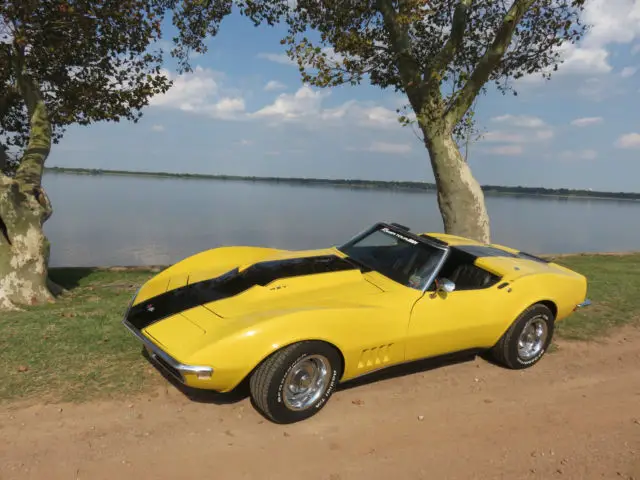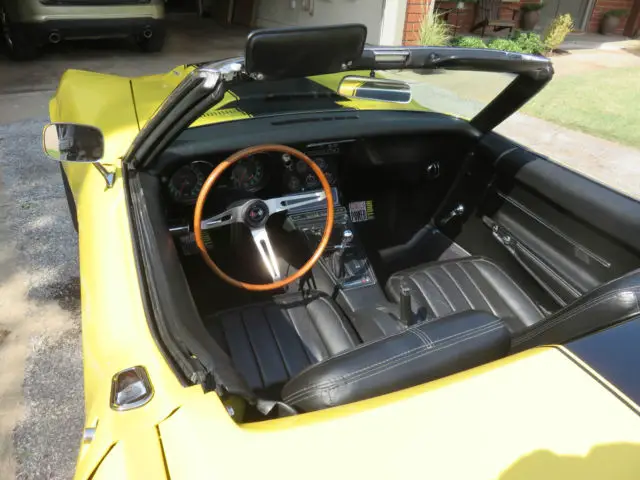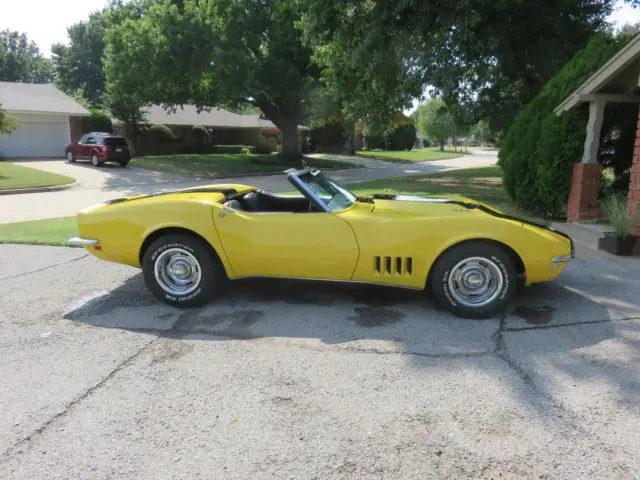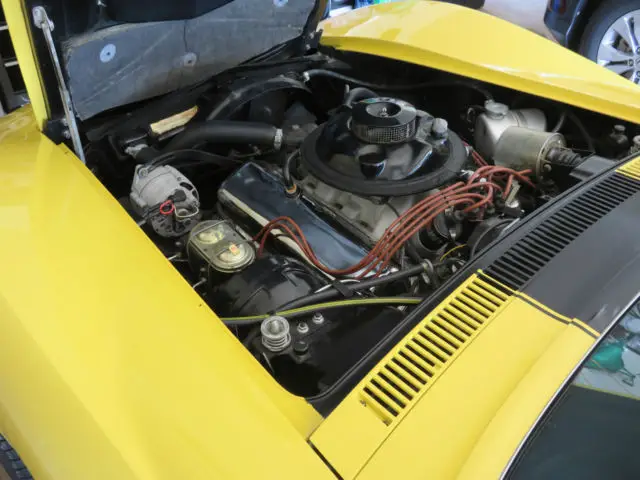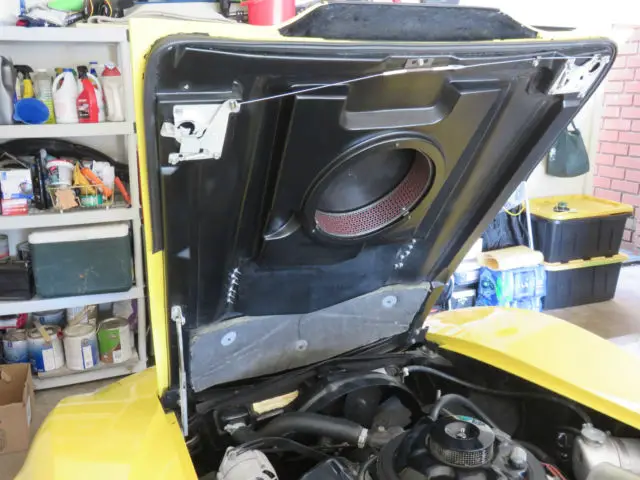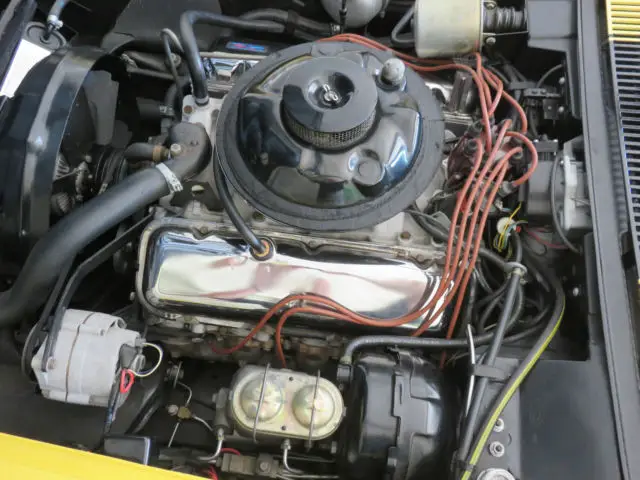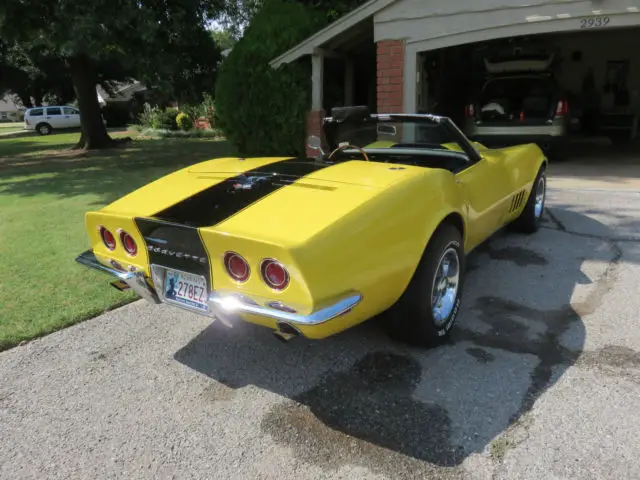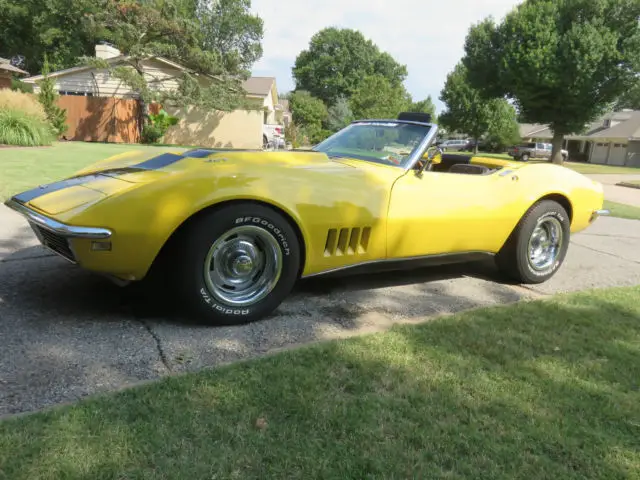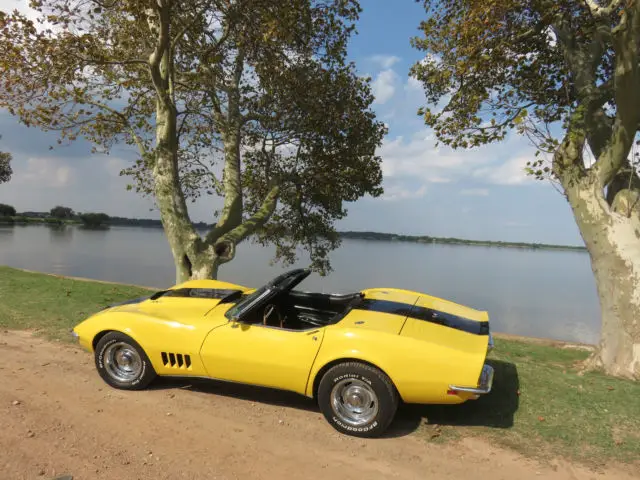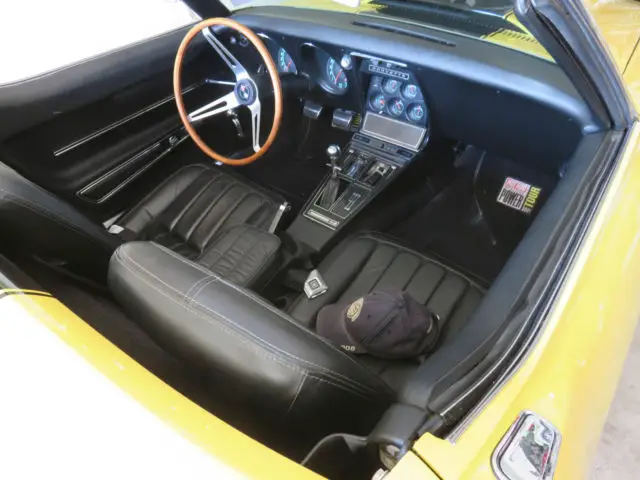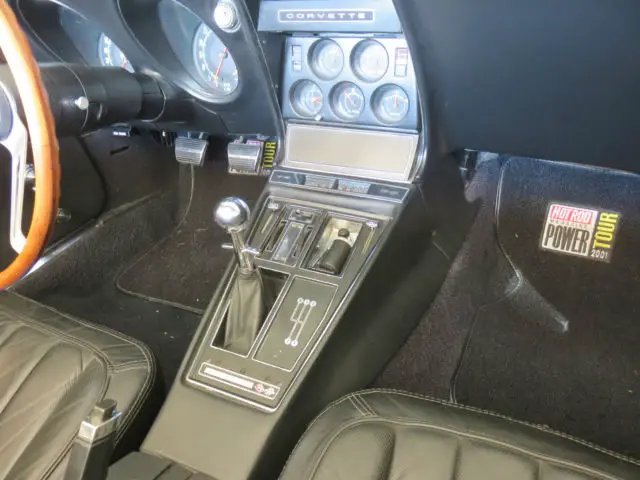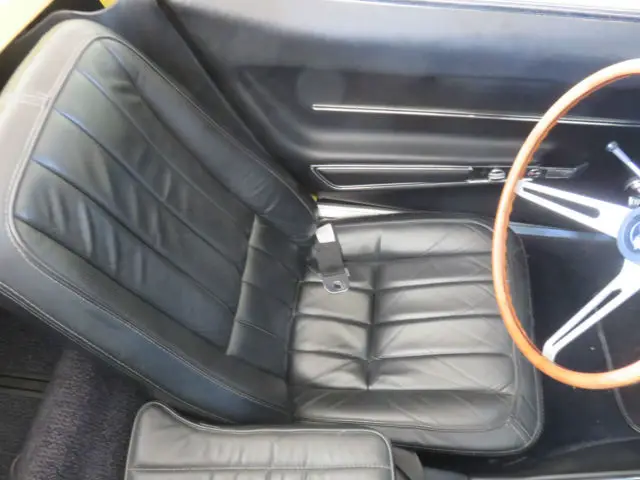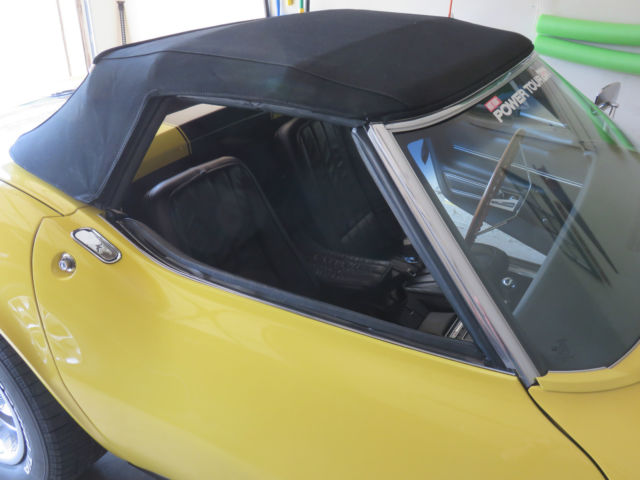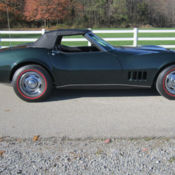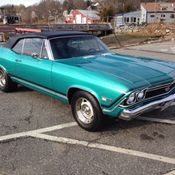1968 Chevrolet Corvette Convertible 7.0L Aluminum ZL-1 Replica
| Condition: | Used |
| Make: | Chevrolet |
| Model: | Corvette |
| SubModel: | ZL-1 |
| Type: | Convertible |
| Trim: | Base Convertible 2-Door |
| Year: | 1968 |
| Mileage: | 85,000 |
| VIN: | 194678S400274 |
| Color: | Yellow |
| Fuel: | Gasoline |
| Transmission: | Manual |
| Drive type: | RWD |
| Interior color: | Black |
| Vehicle Title: | Clear |
| Item location: | Oklahoma City, Oklahoma, United States |
| Extras |
|
Removeable Hard Top, Original Engine with matching numbers, Leather Seats, Convertible |
| Listed by | Private seller |
Description of 1968 Chevrolet Corvette ZL-1 |
|
Fully restored from ground up, t a cost in parts and time that far exceed the asking Bid. This is a reprint of an article Gary wrote for SHARK QUARTERLY MAGAZINE, etailing his quest and success at building this beautiful machine. The main draw for Funfest is, f course, he Fun Field. Walkingaround, ou can see just about anything and everything. Covering both the north and south grounds, ver 5,OOO cars can beparked here. And, n Saturday, t came close to being full.Gary Cluck of Yukon, K, as also a Fun Field winner. Chip Miller quicklypicked this ZL-l replica out of the crowd. And you can see why. We'll let Gary tell his own story... Our trip to the 1997 Funfest event at Mike Yager's Mid America Designfacility pretty much started it all. On the return trip we decided to stopby at the National Corvette Museum and tour the assembly plant atBowling Green. While there, e saw the original 1969 ZL-1 owned(amongst others) by Wayne Walker and now by Roger Judski, f Maitland, L. I was impressed. But since there were only one (or two) ZL-1 carsever built for sale to the public, t was clear that I couldn't buy one. SoI decided I would build one. I had originally thought that I would haveto find a 1969 car but, fter researching the matter, found itdidn't really matter. In 1969 Zori Duntov built his ZL-I mule using aleftover 1968 (according to GM records) so I figured this would begood enough for me. too. The first car I found, hether a 1968 or'69,would be the car that I would rebuild. I planned to do a car thatwould look as close to original as possible but with current parts andtechnology. The car I eventually found, n March 30, 998, ame from St. Louiswith a 390hp big block, -2O, D positraction, adio and full wheelcovers. Corvette Bronze in color with Tobacco interior. The car alsohappened to have a low serial number (19467854AA274). As we weredoing our work we found that a lot of the pieces had been stamped as"Sample OK" or "PilotJob" The car was a total wreck. There was no fiberglass in front of thedoors. The rear end was intact but with a rather high lip on the spoiler.I thought I could repair this, ut as it turned out the whole rear sectionhad been hit and repaired too many times. It would all have to bereplaced. At some point in time the drive shaft had blown, aking thebattery box with it. It had been cobbled together with matte and resin,but this was going to have to be replaced too. The work on the body started around July 15,1998. Front fenders,hood surround, nd lower valances were replaced with NOS GM parts.The rear deck, enders, ail lamp and filler panels are GM reproduction pieces.All bonding strips were bonded-in and the seams were thenground down and reinforced with matte and resin, hen finished. Alldoor seams, op deck lid, ood and headlight openings were aligned tothe width of a paint stick. As you can see from the photos they'repretty close. The underbody was also a mess. The footwells were literally hangingin place. And the floor of the body was covered with small quarter-inch holes...to drain water is my guess. Thankfully, here wasenough of the original material left to re-glass these pieces back to standardform. Once we had all of this back together, ll panels were DA-ed downwith 80 grit paper. This was the last time a power toolwould be used. From here on it was hand sanding to smooth out thehigh spots and fill the low spots. From here to paint was just as intensive. It took four months, fter starting on the body, even days a week, ight hours a day to primeand sand in successive stages. After that we laid down three coats ofDaytona Yellow, hree coats of black for the stripe and three coatsof clear. Now it's ready to color sand and polish, t was a lot of workbut I think that the results speak for themselves. None of this could have been done without the help of Mike Estlack.Mike has worked on Corvettes dating from the late '50s, aving builtseveral radical customs. This is where we acquired our experience; I provided the common labor. Naturally, hile the body was on its dolly for painting, here was otherwork to be done on the chassis. The frame and assorted parts were beadblasted by J&S Stripping in OKC. The same day Frank Pendleton, good friend, pent eight hours rewelding seams and welding 1969kick-up brackets onto the frame. The next day it was primed andpainted with Chevy Chassis Black. Vette Brakes worked with me on a lot of the chassis specifications.I selected the 468 pound front springs and 360 pound compositemono rear leaf spring. Selecting the lighter front springs to reflect the250 pound lighter aluminum engine was an important step in maintaining good handling on the finished product. Sway bars are 1-1/8 inchfront and 3/4 inch on the rear. Vette Brakes also provided the brakes,power booster/master cylinder, otors, tainless steel lines andbraided hoses. The front end also used the VB "super" kit with polybushings. The steering box and trailing arms were sent to Van Steel in Clearwater, L. Their rebuild included making sure the arms were true. Theywere then rebuilt using a stainless steel parking brake kit and finishedoff with Smart Struts from VB. Koni shocks were used on all four corners. Blumenthal Transmission of OKC built the M-22 from NOS parts. Like GM said years ago,"It's a little noisy". Rut with no radio. it sounds like music to my ears. Blumenthalalso rebuilt the differential with a new set of Saginaw 3.55s, s opposed to theoriginal 3.08 gears. The interior was a big success in my mind. The interior of the body wascompletely lined with 27 ounce double foil insulation. All the seamswere sealed with foil tape. This resulted in a cooler-than-expectedride in the Oklahoma summer, ince very little of the heat from theengine or exhaust penetrates through the body. The foil insulation wasthen covered with Al Knoch carpet, hift boot and console. The top is also an Al Knoch product, onstructed from Stayfastfabric, hich is currently used on the new Corvette. The seats were torn down, rames restored and sent to Corvette America to be recovered with basketweave leather. They also suppliedthe door panels and dash pads. The car was built to be driven on a daily basis. Therefore the enginewas built for the street. My first priority was reliability and the secondwas that it must run on pump gas.Marty Morris of Scoggin-Dickey in Lubbock, X, aid "No problem, llI need is money." The engine was built using as many GM Performance Parts as possible.The block is a 1996 re-issue of the original 1969 ZL-1. It is, n fact, hybrid of the Mark 4, and 6engines using what I think are the best features of the three. The headscamecomplete from GMPP, val ports with 2.25 intake valves and1.88 exhaust valves. These were ported before installation. The cam comes from a 502/502 HP GMPP crate engine. There are severalreasons I chose this cam. It's hydraulic. it uses roller lifters. and itsupplies enough vacuum to support the power brakes and othervacuum-operatted items. The crank is a GMPP L-88 and the rods are LS-6/LS-7, aking this a true 427 engine. Oil pump and pan are alsoLS-7 parts. while the pistons are JE forged with 10:1 compression ratio. The carburetor is a correct 1969 ZL-1 4296 850 cfm unit. Ignition is byMSD with a billet tach drive distributor and a 6AL box limited to 6000rpm. The exhaust system consists of Sanderson block-hugger headers (HPC coated) with 2" pipe-. through Walker mufflers. (NOTE The Sanderson headers have since been replaced by GMPP standard exhaust headers) The results from the dyno are a testament to Scoggin-Dickey's abilityto build engines. Torque is rated at 508 lb/ft at 4100 rprn and 528hp at5800 rpm. The engine pulls well from lower rpms with 462 lb/ft on tap at 2800 rpm. The first trip for this car was to the 5th Anniversary at the NationalCorette Museum. Prior to the trip, was contacted by the NCM and asked ifI would like to show the car in the evolution display.Would I? You Bet! The only requirement was that I must drive the car to Bowling Green.My reply was what I have told numerous other people "If you don't drive them,sell them to someone who will" While on display at the NCM the car was noticed by Mike Yager who thoughtit merited his award. Two weeks later, t his event. Chip Millerchose it. It seems that I might have succeeded in creating the car that Iwanted. Gary Cluck, ukon, klahoma |
 Home
Home Contact us
Contact us NEWEST CARS
NEWEST CARS SELL YOUR CAR
SELL YOUR CAR FAQ
FAQ